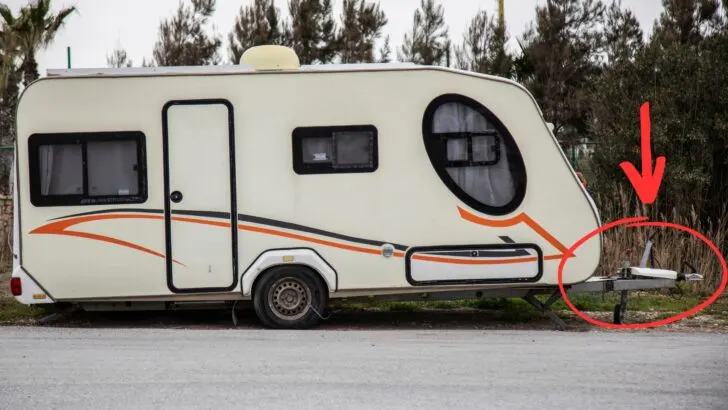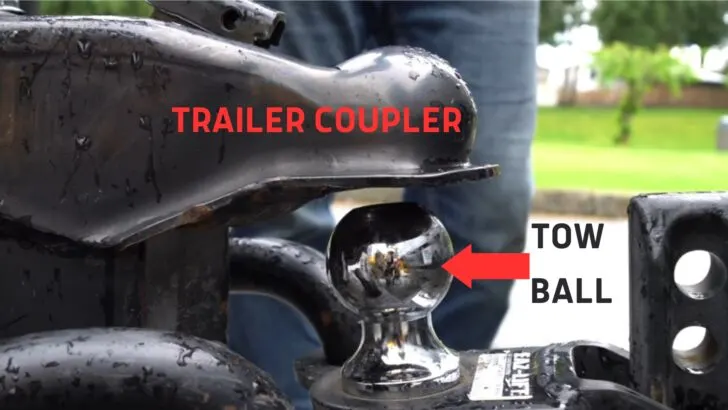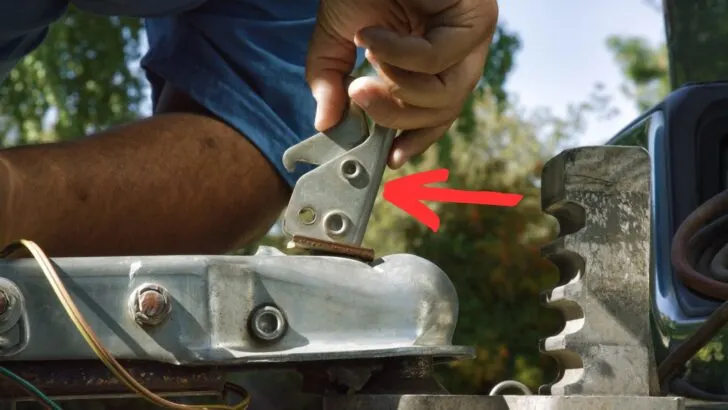Whether you’re pulling a car behind a motorhome, or towing a travel trailer or 5th wheel, towing safety is serious business. So today, we’re taking a close-up look at the trailer tongue and coupler, two sometimes overlooked but very important parts of any trailer towing setup.
If you tow a travel trailer, you’re likely well aware of what the trailer tongue and trailer coupler are. But do you know the part each plays in your safety and the safety of those traveling around you as you tow? It’s crucial to have the proper coupler for your trailer tongue and to attach the mechanisms securely.
So if you’re in the market for a new trailer coupler, you’ll need to sort out a few details before choosing one.
- 1) What Is a Tongue On a Trailer?
- 2) What Are the Trailer Tongue Options?
- 3) Should a Trailer Tongue Be Higher or Lower?
- 4) What Should the Tongue Weight of a Trailer Be?
- 5) What Does a Trailer Coupler Do?
- 6) How Do I Know What Size Trailer Coupler I Need?
- 7) Are Trailer Couplers Welded On?
- 8) Free RVing Tips, Tricks, Reviews, Giveaways & More
What Is a Tongue On a Trailer?
A trailer tongue is the portion of the frame that extends forward from the front of the trailer to the coupler, enabling the frame to be connected to the vehicle towing it. It also provides the space needed to prevent the trailer from striking the back of the towing vehicle in tight turns.

A trailer tongue is the portion of the trailer’s frame that extends forward from the front of the trailer to the coupler.
What Are the Trailer Tongue Options?
It’s important to know what type of trailer tongue you have because the coupler will either bolt or be welded to the trailer tongue and has to match your trailer frame’s tongue type.
The most common types of trailer tongues are:
Straight
A straight trailer tongue is the simplest type, but also the most prone to failure if it gets damaged. That’s because straight tongues are mounted in the center, putting them under considerable vertical stress where the tongue and trailer chassis meet. This makes having the trailer load balanced over the axles critical. A straight trailer tongue requires a straight coupler.
A-Frame
An A-frame trailer tongue is the most common type. It’s very strong, capable of supporting the edges of the trailer from twisting in the event of an uneven load (which should be avoided anyway). A-frame trailers are horizontally and vertically stiff, a quality that’s part of the design to allow the transfer of stress from the tongue itself to the chassis. An A-frame trailer tongue requires an A-frame or flat-mount coupler.
Composite
A composite trailer tongue is commonly used for towing boats. This type of trailer tongue is longer and provides better clearance while reversing. It’s designed to offer strong lateral support to strengthen the tongue and chassis for this purpose.
Should a Trailer Tongue Be Higher or Lower?
A trailer tongue should not be high or low. It should be level for proper, safe towing.

For safe and comfortable towing, your tow vehicle and trailer should be as level as possible.
Tongue/hitch height that’s too high or low will impact the tow ball weight (also referred to as “tow ball mass”).
Tow ball weight/mass is the downward force exerted onto the ball by the tongue of the trailer being towed. Manufacturers of tow vehicles, trailers, hitch receivers, and tow balls all specify the maximum allowable tow ball weight/mass their products can handle. You must stay within those specifications because tow ball weight has a significant impact on your ability to tow your trailer safely.
So, your trailer tongue should be neither higher nor lower. It should be level because if it’s too high or too low, it’ll impact your tow ball mass. For more detail on this important topic, see our full post on proper trailer hitch height.
What Should the Tongue Weight of a Trailer Be?
When you’re towing a trailer, a variety of weights contribute to your towing experience and safety.
Among those is the tongue weight of the trailer, sometimes also referred to as the “hitch weight.” (The term “pin weight” may be used with fifth wheels.) Tongue weight is the downward force the trailer tongue exerts on the hitch ball. The proper tongue weight of a trailer needs to be calculated.
To calculate the tongue weight of your setup, simply take the weight of your tow vehicle alone and subtract it from the weight of your tow vehicle with the trailer attached. In other words, weigh your tow vehicle by itself. Then, with the trailer attached, weigh the truck again (with just the truck itself on the scale — the trailer is attached, but is not on the scale with the tow vehicle).
If the result of your calculation is within the proper tongue weight range for your loaded trailer and the capacity of your hitch and tow vehicle, then your setup is within spec. Otherwise, some adjustments will need to be made.
For more on tongue weight, including additional ways to check it, please see our post “What Is Tongue Weight?”
What Does a Trailer Coupler Do?
As the name implies, the trailer coupler is the device that makes the connection between the hitch ball and the trailer tongue.

The trailer coupler fits over the towing vehicle’s hitch ball, connecting the trailer to the towing vehicle.
So, the coupler is the part of the trailer that attaches to the ball mount on the tow vehicle. In order to ensure a secure connection, the coupler and ball mount must have the same size and weight rating. There are different types of trailer couplers, and the one you would use depends on the shape and style of the tongue of your trailer. Here are the most common types:
Straight-Tongue Coupler
A straight-tongue coupler (or “straight coupler”) has a square tubular mounting sleeve or channel that gets bolted or welded onto a straight trailer tongue. A latch mechanism locks the coupler onto the ball mount.
- PRECISE FIT. This trailer coupler is designed to mount onto a 2-inch wide trailer tongue beam and couple to any standard 2-inch diameter trailer ball
- EASILY ADJUSTABLE. Equipped with a posi-lock spring and adjustable nut on the inside, this trailer hitch coupler can easily be adjusted to ensure a...
A-Frame Coupler
An A-frame coupler has a triangular mounting flange. The flange fits onto an A-shaped trailer tongue and also has a latch mechanism that locks it onto the ball mount. Traditional A-frame couplers are mounted to the top of the trailer’s frame, but to improve ground clearance, underslung couplers are becoming more common (especially for off-road trailers).
- PRECISE FIT. This trailer coupler is designed to mount onto an A-frame trailer tongue and couple to any standard 2-inch diameter trailer ball
- EASILY ADJUSTABLE. Equipped with a posi-lock spring and adjustable nut on the inside, this trailer hitch coupler can easily be adjusted to ensure a...
Channel Mount Coupler
For adjustability, a channel mount coupler has a bracket that can slide on the trailer tongue. Channel mount couplers allow for different height positions to match the particular tow vehicle for level towing.
- EASILY ADJUSTABLE. Designed to mount onto a vertical channel bracket, this trailer hitch coupler can easily be adjusted up or down to ensure level...
- PRECISE FIT. This trailer coupler can be mounted on a wide variety of heavy-duty trailers and couple to any standard 2-5/16-inch diameter trailer ball
Gooseneck Coupler
A gooseneck coupler is a unique type of vertical design specifically made for use on a gooseneck trailer. This vertical coupler allows the user to adjust the height of the trailer. You can see a variety of gooseneck couplers here.
Surge Brake Actuator Coupler
This is a specialized coupler designed specifically for use with hydraulic brakes. If you have this type of braking system, you’ll want your trailer brakes to work synchronously with your tow vehicle brakes via a surge brake actuator coupler. You can see a variety of surge brake actuator couplers here.
How Do I Know What Size Trailer Coupler I Need?
It’s important to choose a coupler that’s the right size and shape for your trailer setup. A coupler attaches to a hitch ball using a latching mechanism that clamps around the ball. It needs to be secure while still allowing for pivoting during turns.
Two factors need to be considered: 1) The frame size & shape of the trailer, and 2) The size of the hitch ball. (Hitch balls are easy to swap out if needed.)

A coupler attaches to a hitch ball using a latching mechanism that clamps around the ball. There are different types of latching mechanisms.
Traditional ball couplers come in a variety of sizes. The most common sizes are 1 7/8″, 2″, and 2 5/16″. But for a traditional hitch ball, just remember that your coupler size needs to match your hitch ball size.
The shape and size of the coupler also needs to match the trailer’s frame. If you have a straight trailer tongue with a standard 2″ hitch, you’ll need to use a standard 2″ coupler. If, on the other hand, you have a 3″ round channel, you’ll need a 3″ round coupler.
Remember, you also need to consider the weight capacity of your trailer coupler. Most are rated for GTW (gross trailer weight). But some are also rated for maximum tongue weight (TW). Every towing setup is only as strong as its weakest component.
Are Trailer Couplers Welded On?
Trailer couplers are either welded onto the trailer frame or bolted on. If your coupler needs to be welded onto the frame, you’ll want to have this done professionally (unless welding is one of your DIY skills). You can choose to weld a bolt-on coupler to your trailer, but you cannot do the reverse. Never bolt a weld-on coupler to your trailer.
We hope this info helps familiarize you with the trailer tongue and coupler, two important components for towing safety.
Free RVing Tips, Tricks, Reviews, Giveaways & More
Subscribe to our daily newsletter! We’ve been full-time RVers for 20 years (!) and share everything we’ve learned about RVing in our daily blog posts. Join our online community to receive a wealth of great RVing knowledge delivered right to your inbox.
Whether this is your first time on the road or you’re a seasoned full-timer, you’ll love the wide range of RVing topics we cover. Don’t miss a single article or any of our famous RV gear Giveaways — Subscribe today!




